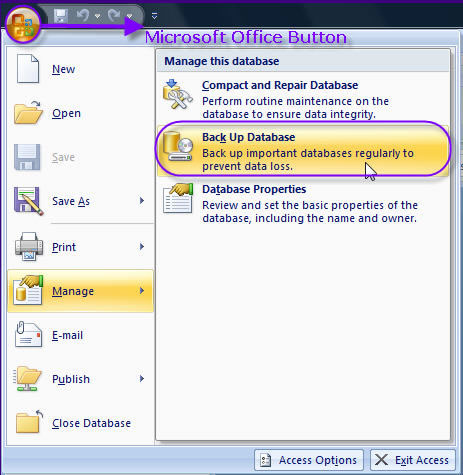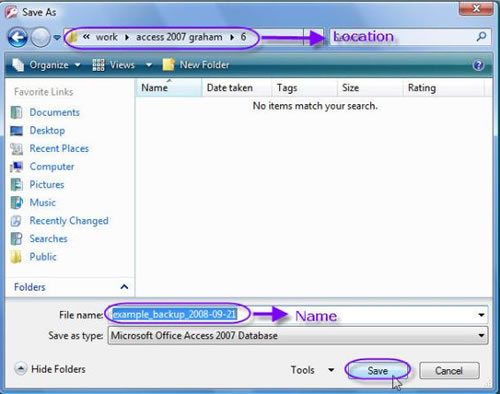databasedev.co.uk - database solutions and downloads for microsoft access
Microsoft Access Articles
- General Microsoft Access Articles
- Microsoft Access 2007 Articles
- Tables
- Queries
- SQL
- Forms
- Reports
- Macros
- Modules & VBA
- Data Models
- Downloads
GUI Design
Resources
Online Shop
Info
Microsoft Access 2007
Backing up a Microsoft Access 2007 Database
One of the rules of protecting your work and data is backing it up. We learned it from the first computer science class and we all do it, whether it’s saving your vacation photos on a flash disk or burning a cd with the latest book you wrote. This also applies to databases: using a back-up easily protects against any data loss. Plus, by reverting to an older version you can "undo" actions that the command "undo" is not able to help you with.
Note: the tutorial only talks about how to back up a database. If the records keep growing regularly you can consider archiving an older database, when you can move older records from a table in an active database to a table in an archive database. Also, you can use software which performs automatic backups of a file system.
Important: consider doing the backup before you run an active query which will delete or change records because Undo cannot fix any change done by that manner. In general, it’s advisable to back-up the database right after you populated the tables and before you run any query.
Tip: for best protection, copy the back-up file on a device you keep off site. For example I back up my work regularly on a flash disk which is attached to my key chain.
When do I need to back up a database?
Consider the following situation to decide whether you should or shouldn’t back-up:
- You SHOULD back up if your database is an archive or it’s used for reference only. When any of the data changes make sure to back up the database.
- You SHOULD back up an active database if you make frequent changes. Make a back up scheduled (example: every Friday before you leave work) and stick with it!
- You SHOULD back up a database which contains only linked tables. Every time you change the design, you need to back up the data base.
What happens when I back up?
Microsoft Access 2007 saves and closes every object open in Design View. It also compacts and repairs the database and then saves a copy in the location you specify and using the name you choose. After the back-up is done, Microsoft Access 2007 reopens the objects closed earlier.
How to back up using Microsoft Access 2007
- Open the Database you need to back up
- Click the Microsoft Office Button (top left), point to Manage,
choose and in the list of tasks choose Back up Database.

Fig 1. Choose the "Back up Database" task - Choose the name and the location. By default Access 2007 also
adds the date of the backup, which makes it easy to track. Click
save to start the backup process.
Important: For ease of figuring out what you have just backed up keep the name, but add backup to the name. Save in ANOTHER location and then you can even copy the back-up file on a flash disk.

Fig 2. Choose the location, name and click Save
And this is it, you have successfully backed up a data base.
What about a split database? How do I back up it?
Typically, a split database consists of two database files: a back-end database, which contains only data in tables, and a front-end database, which contains links to the tables in the back-end database, plus all the queries, reports, etc.
To back it up, you can need to back up both the back-end and front-end. Make sure to back up more often the back end since it contains the data. The steps are exactly the ones presented above. Back-up the front-end database right after you make ANY design changes.
See the article on Splitting A Microsoft Access Database for more details.
 Microsoft
Office Access 2007 Desktop Databases
Microsoft
Office Access 2007 Desktop Databases
Microsoft Access is an application used to create small and midsize computer desktop databases for the Microsoft Windows family of operating systems. It can also be used as a database server for a web-based application.
This electronic book (ebook) provides lessons on how to use Microsoft Office Access 2007 to create and manage databases. The lessons follow a step-by-step format with practical examples.
Download the ebook now - Microsoft Office Access 2007 Desktop Databases